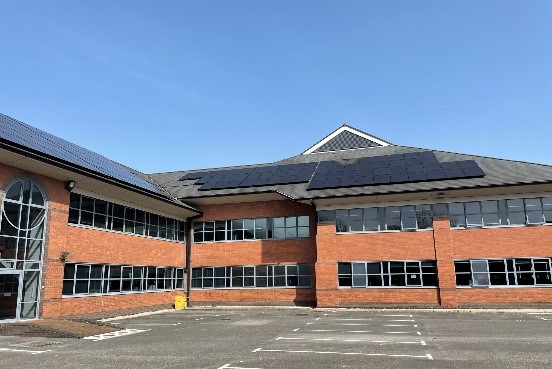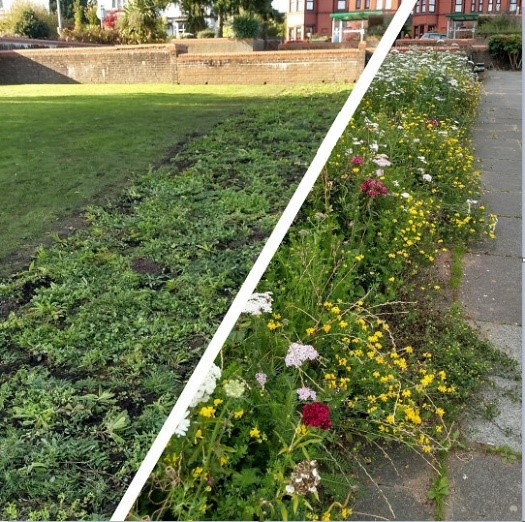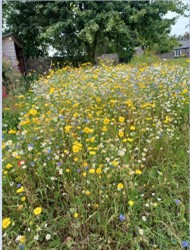Climate Change Newsletter Edition 4
Energy savings in schools.
Flintshire County Council have been busy reducing energy use and subsequent carbon emissions from over 26 of our schools across the county. We have been reducing energy by changing over old fluorescent bulbs for energy efficient alternatives such as LEDs, fitting lighting sensors in low use areas to avoid lights being left switched on, installation of pool covers in leisure centres to contain heat in the pool water, heating upgrades to lower energy alternatives, and installation of building mounted renewable energy generation such as solar and wind.

Why are we reducing energy use in schools?
A reduction in electricity usage translates directly into a reduction in carbon emissions, and by installing renewable energy generation the school can benefit from its own electricity. These are really important steps towards our aim to be a Net Zero Carbon Council by 2030, reduce the costs paid by the school for energy, and it is also a really good opportunity to get the pupils involved in thinking about climate change and what actions we can all take.

Did you know?
National Walking Month.
Flintshire has many accessible walking routes which are all over the county ranging from coastal paths to country parks. Our access team have devised a number of route maps which range from 1- 2 miles in Flint, Buckley, Caerwys, Ewloe, Hope and Caergwrle.
We also have an interactive Map under the rights of way section where you will find all the footpaths across Flintshire.
Keep your eyes peeled for the new Flintshire Rural walks booklet which is coming out soon.
How do I get involved?
National walking month is from the 1 to the 31 of May. You can get involved for as little as 20 minutes a day to 40 minutes a day, dependent on your level of fitness and your schedule. You can make little adjustments in your day to gain a little more time walking and a little more time outside.
- Park further away from your destination/hop off the bus a stop earlier.
- Go for a lunchtime/evening stroll.
- Choose the scenic route.
- Visit local parks/walking routes with friends and family.
- Walk to your local shops.
Walking is something that you can do for free and work your whole body. You can fit it into your daily schedule by adding little 10-20 minute walks in if you don’t have time for a 30-40 minute walk in one go.
Why is walking important?
Walking counts towards your recommended level of physical activity. If you walk for 30 minutes a day, at least 5 days a week, you can start to feel some of the great benefits of walking such as improved energy, reduced stress, and improved sleep, as well as combatting chronic illness such as heart disease and depression.
Why is this important for climate change?
Reduces air pollution.
By choosing to walk more often instead of using your car or public transport it reduces the amount of air pollution. The emissions from burning petrol and diesel not only pollute the air we breathe potentially causing health issues, but also contribute to climate change due to the harmful greenhouse gasses that trap heat into our atmosphere - warming the planet.
Reduces noise pollution.
By walking more it helps to reduce the amount of vehicles using the roads which lowers congestion and the noise which comes from engines. Noise pollution disturbs not only animals/habitats but also humans too.
Wildflower work within Flintshire.
Over the last few years, the council has been introducing wildflower areas and areas of reduced mow to support nature and the wellbeing of our communities as part of the biodiversity duty plan “Supporting Nature in Flintshire”.
Why are wildflowers important?
A more diverse grassland estate provides multiple benefits including visual and noise barriers along our roads, increased pollution and water absorption, improved carbon storage and a home and food source for our wildlife.
With only 2% of traditional grassland habitats left in the UK this step has potential to create important habitat throughout the county, supporting vital pollinators and a healthy natural environment which is important for resident wellbeing.

How are these sites managed throughout the year?
Our wildflower sites are managed through a reduce mow scheme. This consists of one cut and collect a year between August and September. It is essential that cuttings are collected and removed. This reduces fertility and subsequently; the ‘vigour’ of the grasses year on year, which favours the continued establishment of perennial flowering species. (Species which lives more than two years)
Where can this work be seen in Flintshire?
To date we have 196 sites across Flintshire managed for wildflowers, with many sites easily visible along road verges and roundabouts. These include: Buckley Common, Connahs Quay Library, Gwaenysgor village green, and road verge of A548 in Bagillt, and roundabouts such as Pen Y Ffordd, Mold, Shotton and Greenfield.

So, keep your eyes peeled for an explosion of colour this summer on these mini-meadows!
Important policy changes.
Over the past year the biodiversity team have been working hard to make some changes to the current grass cutting policy. Earlier this year, Streetscene and biodiversity staff held a workshop for councillors to discuss local biodiversity loss, the impacts of herbicide use and opportunities for changes in practice.
In a significant step the Scrutiny Committee approved policy changes which extend reduced mow and cut and collect management beyond our wildflower sites. The policy now contains steps to support nature in each of the areas it covers whilst always prioritising road user safety and ensuring our sites look intentional through the use of mown borders, paths and signage where needed. Community response has been overwhelmingly positive about these changes.
This Month!
No Mow May.
What is No Mow May?
No Mow May is an annual campaign which looks at the importance of letting your gardens grow and flourish during the month of May. It is important to know that keeping it long all year isn’t the best option - it is recommended a layered approach with two tone that boosts floral diversity, nectar and pollen production throughout theyear.
Why is it important?
Since the 1930’s, Britain has lost nearly 7.5 million acres of meadows rich in wildflowers and grazing land. These rich meadows can contain hundreds of species of plant which can support complex webs of mammals, invertebrates, birds, fungi. Without these meadows and grazing land it results in a loss of biodiversity, however we have 15 million gardens, which has the potential for a major source of nectar.
How to get involved?
You can get involved by leaving your lawnmower in the shed for the whole month of May and watch your garden flourish into a little home for wildlife. Plantlife have their own campaign with a newsletter which will keep you updated on all things No Mow May.